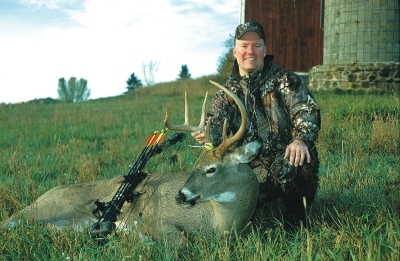
As seen in this week’s episode of Deer & Deer Hunting TV on Versus, whitetail oddities run in all sorts of shapes and sizes. One of the most common questions I’ve received over the years centers on whitetail bucks that have one goofy-looking antler and one "normal" antler.
Many things can cause a giant buck to grow weird antlers, but injuries more often than not are the culprit. There is strong evidence that an injury to a velvet pedicle will cause the deer to grow an abnormal antler on the other side of its head. This is known in the scientific world as the "contralateral effect."
What essentially happens here is that the buck’s internal chemistry takes over and redirects that energy to other parts of the deer. This is believed to be a survival mechanism. Many times, bucks exhibiting this antler effect will be much larger in the body. That was the case with the buck pictured above. I shot this 4-1/2-year-old buck about 10 years ago, and his is still the heaviest whitetail I have ever killed. He weighed 284 pounds on the hoof. His antler configuration was a clean 5-point side and a 21-inch beam with only a brow tine on the other side. When I skinned this buck, I learned that his right hind leg had suffered a serious wound. Encased in a cyst in that leg was a fist-sized ball of scar tissue. This injury undoubtedly led to the contralateral effect on that opposite antler. Think about this the next time you field dress a deer that might have a similar rack. You just might find the reason behind his antler configuration.
I should note that our Deer & Deer Huntingfield editors believe the contralateral effect isn’t necessarily a permanent condition. For example, Charles Alsheimer has told me that he has seen several deer recover from this condition and grow normal racks in subsequent years. This, he said, is usually dictated by the extent of the injury.
